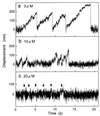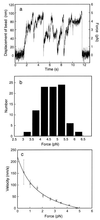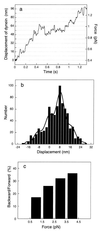Processive movement of single 22S dynein molecules occurs only at low ATP concentrations
- PMID: 10706634
- PMCID: PMC15963
- DOI: 10.1073/pnas.050585297
Processive movement of single 22S dynein molecules occurs only at low ATP concentrations
Abstract
We have analyzed the movement of single 22S dynein molecules from Tetrahymena cilia by using a nanometer measuring system equipped with optical tweezers. Statistical analysis proved that a single molecule of 22S dynein can move processively and develop force at low concentrations of ATP (<20 microM). The maximum force was approximately 4.7 pN, and the force-velocity curve was convex down. During force development, dynein molecules showed stepwise displacement of approximately 8 nm and frequently exhibited backward steps of approximately 8 nm. At higher concentrations of ATP (>/=20 microM) single molecules of 22S dynein were not observed to move processively. Twenty-two S dynein seems to switch over from a processive mode to a nonprocessive mode, sensing a subtle change of ATP concentrations. These observations indicate that the processivity, maximum force, and step size of dynein are similar to those of kinesin, but the ATP concentration-dependence, force-velocity relationship, and backward steps are clearly distinct from kinesin.
Figures




References
Publication types
MeSH terms
Substances
LinkOut - more resources
Full Text Sources

